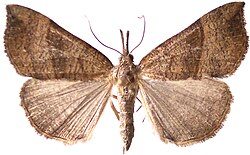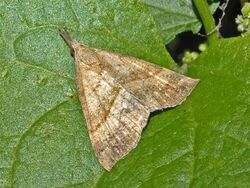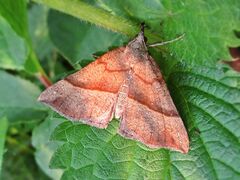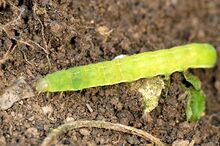Biology:Hypena proboscidalis
| Hypena proboscidalis | |
|---|---|

| |
| H. proboscidalis from Eure-et-Loir, France | |

| |
| Scientific classification Error creating thumbnail: Unable to save thumbnail to destination
| |
| Domain: | Eukaryota |
| Kingdom: | Animalia |
| Phylum: | Arthropoda |
| Class: | Insecta |
| Order: | Lepidoptera |
| Superfamily: | Noctuoidea |
| Family: | Erebidae |
| Genus: | Hypena |
| Species: | H. proboscidalis
|
| Binomial name | |
| Hypena proboscidalis | |
Hypena proboscidalis, the snout, is a moth of the family Erebidae. The species was first described by Carl Linnaeus in his 1758 10th edition of Systema Naturae.
Distribution and habitat
This species is found in Europe in the north to the Arctic Circle.[1] To the east it ranges across the Palearctic including North Africa, Siberia, Iran, the Altai Mountains, Kamchatka, Kashmir, India , China , Korea, Japan and Taiwan.[2] In the Alps and India, it rises to elevations of over 1600 metres.
Technical description and variation
The wingspan is 25–38 mm.[3] Its forewings are grey brown with numerous dark transverse striae, and with a brownish-yellow suffusion in the females; the lines dark brown; the inner curved or bent in middle; the outer oblique, nearly straight, slightly incurved at costa, internally shaded with dark brown; the subterminal cloudy and partially interrupted, above middle marked with black white-tipped dashes, followed by a brown cloud, the subapical edge of which is oblique; hindwing pale greyish.
As a rule most females are brownish, — ab. brunnea Tutt, —- most males grey without the brown; - the form deleta Stgr., from the Altai Mts., Amurland, and Kamschatka, is paler, the forewing yellowish, sprinkled with brown, with less distinct markings; - tatorhina Btlr. [full species Hypena tatorhina Butler, 1879] from Japan, is small, grey in both sexes, with dingy fuscous suffusion, and a black spot in cell; the hindwing fuscous; - from W. China (Omei-shan and Tatsienlu) comes a form. — subsp. flexilinea subsp. nov. [Warren] dark grey brown in the female, with the transverse striae and the shades preceding the lines dark smoky fuscous, the outer line visibly bent above middle; in the males the dark shading is slight: --a similar but smaller form - indicalis Guen., occurs in the Goorais Valley. Kashmir, where the outer line has a tendency to be elbowed on both folds, and the male, which is quite without dark shading, has a small black dot in cell and a large black spot at its end.[4]
Biology

The moth flies in two generations from May to September.[1]
Larvae are velvety green with the dorsal line darker green; the subdorsal lines paler; head, legs, and tubercles green. The larvae feed on hop (Humulus species), nettle (Urtica species), ground-elder (Aegopodium sp.) and Stachys species.[2][5]
Habitats include deciduous, mixed and coniferous forests, rivers, hedges and gardens and parkland.
Notes
- ^ The flight season refers to Belgium and the Netherlands. This may vary in other parts of the range.
References
- ↑ Fauna Europaea
- ↑ 2.0 2.1 Savela, Markku (26 July 2019). "Hypena proboscidalis (Linnaeus, 1758)". https://www.nic.funet.fi/pub/sci/bio/life/insecta/lepidoptera/ditrysia/noctuoidea/erebidae/hypeninae/hypena/#proboscidalis. Retrieved 12 February 2020.
- ↑ Kimber, Ian. "72.003 BF2477 The Snout Hypena proboscidalis (Linnaeus, 1758)". https://ukmoths.org.uk/species/hypena-proboscidalis. Retrieved 12 February 2020.
- ↑ Seitz, A. Ed., 1914 Die Großschmetterlinge der Erde, Verlag Alfred Kernen, Stuttgart Band 3: Abt. 1, Die Großschmetterlinge des palaearktischen Faunengebietes, Die palaearktischen eulenartigen Nachtfalter, 1914
- ↑ Mazzei, Paolo; Morel, Daniel; Panfili, Raniero. "Hypena (Hypena) proboscidalis (Linnaeus, 1758)". https://www.leps.it/indexjs.htm?SpeciesPages/HypenProbo.htm. Retrieved February 12, 2020.
External links
- "08994 Hypena proboscidalis (Linnaeus, 1758) - Nessel-Schnabeleule". Lepiforum e. V.
- "Bruine snuituil Hypena proboscidalis". De Vlinderstichting. (in Dutch)
Wikidata ☰ Q217603 entry
 |




